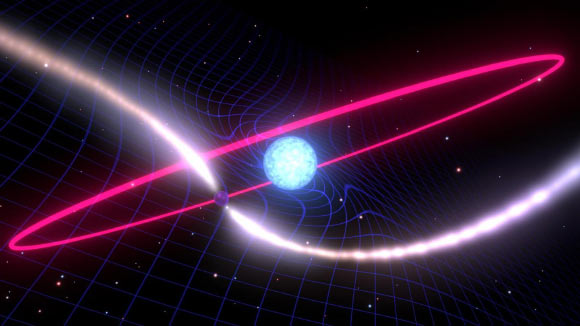Exotic Binary System Confirms Relativistic Frame-Dragging | Astronomy, Physics – Sci-News.com
An international team of astronomers has found exciting new evidence for Lense-Thirring precession — an effect of relativistic frame-dragging — after tracking the pulsar-white dwarf binary system PSR J1141-6545 for almost two decades.

An artist’s depiction of a rapidly spinning neutron star and a white dwarf dragging the fabric of spacetime around its orbit. Image credit: Mark Myers, OzGrav ARC Centre of Excellence.
When a massive object rotates, general relativity predicts that it pulls the surrounding spacetime around with it, a phenomenon known as frame-dragging.
This phenomenon causes precession of the orbital motion of gravitationally bound objects.
While frame-dragging has been detected by satellite experiments in the gravitational field of the rotating Earth, its effect is tremendously small and challenging to measure.
More massive objects, such as white dwarfs or neutron stars, provide a better opportunity to observe the phenomenon under much more intense gravitational fields.
“One of the first confirmations of frame-dragging used four gyroscopes in a satellite in orbit around the Earth, but in our system the effects are 100 million times stronger,” said Dr. Norbert Wex, a researcher in the Max Planck Institute for Radio Astronomy.
Dr. Wex, Dr. Vivek Venkatraman Krishnan, also from the Max Planck Institute for Radio Astronomy, and their colleagues used CSIRO’s 64-m Parkes radio telescope to observe PSR J1141-6545, a young pulsar in a binary orbit with a white dwarf.
The scientists measured the arrival times of the pulses to within 100 microseconds, over a period of nearly twenty years, which allowed them to identify a long-term drift in the orbital parameters.
After eliminating other possible causes of this drift, they concluded that it is the result of Lense-Thirring precession due to the rapidly rotating white dwarf companion.
The findings confirm the prediction of general relativity and allowed the team to constrain the white dwarf’s rotational speed.
“At first, the stellar pair appeared to exhibit many of the classic effects that Einstein’s theory predicted. We then noticed a gradual change in the orientation of the plane of the orbit,” Dr. Krishnan said.
“We postulated that this might be, at least in-part, due to the so-called frame-dragging that all matter is subject to in the presence of a rotating body as predicted by the Austrian mathematicians Lense and Thirring in 1918,” said Dr. Paulo Freire, also from the Max Planck Institute for Radio Astronomy.
“In a stellar pair, the first star to collapse is often rapidly rotating due to subsequent mass transfer from its companion. In this system the entire orbit is being dragged around by the white dwarf’s spin, which is misaligned with the orbit,” said Aarhus University’s Professor Thomas Tauris.
“Pulsars are super clocks in space. Super clocks in strong gravitational fields are Einstein’s dream laboratories,” said SKA Organisation’s Dr. Evan Keane.
“We have been studying one of the most unusual of these in this binary star system. Treating the periodic pulses of light from the pulsar like the ticks of a clock we can see and disentangle many gravitational effects as they change the orbital configuration, and the arrival time of the clock-tick pulses.”
“In this case we have seen Lens-Thirring precession, a prediction of general relativity, for the first time in any stellar system.”
“After ruling out a range of potential experimental errors, we started to suspect that the interaction between the white dwarf and neutron star was not as simple as had been assumed to date,” said Dr. Willem van Straten, from the Auckland University of Technology.
The findings are published in the journal Science.
_____
V. Venkatraman Krishnan et al. 2020. Lense-Thirring frame dragging induced by a fast-rotating white dwarf in a binary pulsar system. Science 367 (6477): 577-580; doi: 10.1126/science.aax7007






